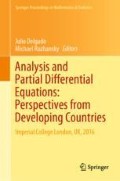Abstract
Turing-Hopf instabilities for reaction-diffusion systems provide spatially inhomogeneous time-periodic patterns of chemical concentrations. In this presentation, it is shown the parameter space in which the reaction-diffusion system modelling glycolysis and the Lengyel-Epstein model could show twinkling patterns. To do so, we follow the Ricard-Mischler procedure in Ricard and Mischler (J Nonlinear Sci 19(5):467–496, 2009, [18]), i.e., considering this phenomenom as a consequence of the instability generated by diffusion on the limit cycle which appears due to a Hopf bifurcation about the spatially homogeneous steady state.
Access this chapter
Tax calculation will be finalised at checkout
Purchases are for personal use only
References
Baurmann, M., Gross, T., Feudel, U.: Instabilities in spatially extended predator-prey systems: spatio-temporal patterns in the neighborhood of Turing-Hopf bifurcations. J. Theor. Biol. 245(2), 220–229 (2007)
Bogoliubov, N.N., Mitropolski, Y.A.: Asymptotic Methods in the Theory of Nonlinear Oscillations. Gordon and Breach Science Publishers, New York (1961)
Díaz Rodrígues, L.A., Mistro, D.C., Petrovskii, S.: Pattern formation, long-term transients, and the Turing-Hopf Bifurcation in a space- and time-discrete predator-prey system. Bull. Math. Biol. (2010). https://doi.org/10.1007/s11538-010-9593-5
Egaña Fernández, G., Rodríguez Ricard, M.: Emergence and collapse of limit cycles in the glycolysis model. Revista Investigación Operacional 39(1), 23–32 (2018)
Henry, D.: Geometric Theory of Semilinear Parabolic Equations. Springer, New York (1981)
Just, W., Bose, M., Bose, S., Engel, H., Schöll, E.: Spatiotemporal dynamics near a supercritical Turing-Hopf bifurcation in a two-dimensional reaction-diffusion system. Phys. Rev. E. 64(026219), 1–12 (2001). https://doi.org/10.1103/PhysRevE.64.026219
Kuznetsov, YuA: Elements of Applied Bifurcation Theory. Applied Mathematical Sciences, vol. 112, 3rd edn. Springer Science+Business Media, New York (2004)
Lacitignola, D., Bozzini, B., Sgura,I.: Spatio-temporal organization in a morphochemical electrodeposition model: Hopf and Turing instabilities and their interplay. Eur. J. Appl. Math. (2014). https://doi.org/10.1017/S0956792514000370
Leiva, H.: Stability of a periodic solution for a system of parabolic equations. Appl. Anal. 60, 277–300 (1996)
Lengyel, I., Epstein, I.R.: Global bifurcation and structure of Turing patterns in the 1-D Lengyel-Epstein model. Sciences 251, 650–652 (1991)
Lengyel, I., Epstein, I.R.: A chemical approach to designing Turing patterns in reaction-diffusion system. Proc. Natl. Acad. Sci. USA 89, 3977–3979 (1992)
Liu, P., Shi, J., Wang, Y., Feng, X.: Bifurcation analysis of reaction-diffusion Schnakenberg model. J. Math. Chem. 51, 2001–2019 (2013). https://doi.org/10.1007/s10910-013-0196-x
Marsden, J.E., McCracken, M.: The Hopf Bifurcation and its Applications. Springer, New York (1976)
Meixner, M., De Wit, A., Bose, S., Schöll, E.: Generic spatiotemporal dynamics near codimension-two Turing-Hopf bifurcations. Phys. Rev. E 55(6), 6690–6697 (1997)
Murray, J.D.: Mathematical Biology I: An Introduction. Interdisciplinary Applied Mathematics, vol. 17, 3rd edn. Springer, New York (2001)
Murray, J.D.: Mathematical Biology II: Spatial Models and Biomedical Applications. Interdisciplinary Applied Mathematics, vol. 18, 3rd edn. Springer, New York (2003)
Ricard, M.R.: On degenerate planar Hopf bifurcations. J. Phys. A. Math. Theor. 44, 065202 (2011)
Ricard, M.R., Mischler, S.: Turing instabilities at Hopf bifurcation. J. Nonlinear Sci. 19(5), 467–496 (2009). https://doi.org/10.1007/s00332-009-9041-6
Rudin, W.: Principles of Mathematical Analysis, 3rd edn. McGraw-Hill, New York (1976)
Sanders, J.A., Verhulst, F., Murdock, J.: Averaging Methods in Nonlinear Dynamical Systems. Applied Mathematical Sciences, vol. 59, 2nd edn. Springer, New York (2007)
Sarría-González, J., Ricard, M.R.: Twinkling patterns for the Lengyel-Epstein reaction-diffusion model (2018) (in preparation)
Settani, G., Sgura, I.: Devising efficient numerical methods for oscillating patterns in reaction-diffusion systems. J. Comput. Appl. Math. (2015). https://doi.org/10.1016/j.cam.2015.04.044
Sgura, I., Bozzini, B., Lacitignola, D.: Numerical approximation of Turing patterns in electrodeposition by ADI methods. J. Comput. Appl. Math 236, 4132–4147 (2012)
Sgura, I., Bozzini, B., Lacitignola, D.: Numerical approximation of oscillating Turing patterns in a reaction-diffusion model for electrochemical material growth. In: AIP Conference Proceedings, vol. 1493, pp. 896–903. Melville, New York (2012). https://doi.org/10.1063/1.4765594
Strier, D.E., Ponce, D.S.: Turing patterns inside cells. PLoS ONE 2, (10), e1053 (2007). https://doi.org/10.1371/journal.pone.0001053
Turing, A.M.: The chemical basis for morphogenesis. Philos. Trans. R. Soc. Lond. B 237, 37–72 (1952)
Wang, L., Zhao, H.: Hopf bifurcation and Turing instability of 2-D Lengyel-Epstein system with reaction-diffusion terms. Appl. Math. Comput. 21, 9229–9244 (2013)
Wu, X.P., Eshete, M.: Bautin bifurcation for the Lengyel-Epstein system. J. Math. Chem. 52, 2570–2580 (2014). https://doi.org/10.1007/s10910-014-0401-6
Yang, L., Berenstein, I., Epstein, I.R.: Segmented Waves from a Spatiotemporal Transverse Wave Instability. Phys. Rev. Lett. 95, 3, 038303 (2005). https://doi.org/10.1103/PhysRevLett.95.038303
Yi, F., Wei, J., Shi, J.: Diffusion-driven instability and bifurcation in the Lengyel-Epstein system. Nonlinear Anal. Real World Appl. 9, 1038–1051 (2008)
Zhou, J., Shi, J.: Pattern formation in a general glycolysis reaction-diffusion system. IMA J. Appl. Math. 13, 1–36 (2015). https://doi.org/10.1093/imamat/hxv013
Acknowledgments
Mariano Rodríguez Ricard would like to express his gratitude to the organizers of the ODA Week at Imperial College London (Nov 23-28, 2016), Prof. Michael Ruzhansky and Dr. Julio Delgado, for their support and cordiality during the workshop.
Author information
Authors and Affiliations
Corresponding author
Editor information
Editors and Affiliations
Rights and permissions
Copyright information
© 2019 Springer Nature Switzerland AG
About this paper
Cite this paper
Egaña Fernández, G., Sarría González, J., Ricard, M.R. (2019). “Strong” Turing-Hopf Instability for Reaction-Diffusion Systems. In: Delgado, J., Ruzhansky, M. (eds) Analysis and Partial Differential Equations: Perspectives from Developing Countries. Springer Proceedings in Mathematics & Statistics, vol 275. Springer, Cham. https://doi.org/10.1007/978-3-030-05657-5_9
Download citation
DOI: https://doi.org/10.1007/978-3-030-05657-5_9
Published:
Publisher Name: Springer, Cham
Print ISBN: 978-3-030-05656-8
Online ISBN: 978-3-030-05657-5
eBook Packages: Mathematics and StatisticsMathematics and Statistics (R0)

